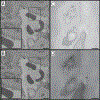Serial Block-Face Scanning Electron Microscopy (SBF-SEM) of Biological Tissue Samples
- PMID: 33843931
- PMCID: PMC8225236
- DOI: 10.3791/62045
Serial Block-Face Scanning Electron Microscopy (SBF-SEM) of Biological Tissue Samples
Abstract
Serial block-face scanning electron microscopy (SBF-SEM) allows for the collection of hundreds to thousands of serially-registered ultrastructural images, offering an unprecedented three-dimensional view of tissue microanatomy. While SBF-SEM has seen an exponential increase in use in recent years, technical aspects such as proper tissue preparation and imaging parameters are paramount for the success of this imaging modality. This imaging system benefits from the automated nature of the device, allowing one to leave the microscope unattended during the imaging process, with the automated collection of hundreds of images possible in a single day. However, without appropriate tissue preparation cellular ultrastructure can be altered in such a way that incorrect or misleading conclusions might be drawn. Additionally, images are generated by scanning the block-face of a resin-embedded biological sample and this often presents challenges and considerations that must be addressed. The accumulation of electrons within the block during imaging, known as "tissue charging," can lead to a loss of contrast and an inability to appreciate cellular structure. Moreover, while increasing electron beam intensity/voltage or decreasing beam-scanning speed can increase image resolution, this can also have the unfortunate side effect of damaging the resin block and distorting subsequent images in the imaging series. Here we present a routine protocol for the preparation of biological tissue samples that preserves cellular ultrastructure and diminishes tissue charging. We also provide imaging considerations for the rapid acquisition of high-quality serial-images with minimal damage to the tissue block.
Figures













Similar articles
-
Development of protocols for the first serial block-face scanning electron microscopy (SBF SEM) studies of bone tissue.Bone. 2020 Feb;131:115107. doi: 10.1016/j.bone.2019.115107. Epub 2019 Oct 24. Bone. 2020. PMID: 31669251 Free PMC article. Review.
-
Towards the imaging of Weibel-Palade body biogenesis by serial block face-scanning electron microscopy.J Microsc. 2015 Aug;259(2):97-104. doi: 10.1111/jmi.12222. Epub 2015 Jan 23. J Microsc. 2015. PMID: 25644989 Free PMC article.
-
Combining serial block face and focused ion beam scanning electron microscopy for 3D studies of rare events.Methods Cell Biol. 2019;152:87-101. doi: 10.1016/bs.mcb.2019.03.014. Epub 2019 May 7. Methods Cell Biol. 2019. PMID: 31326028
-
Resin comparison for serial block face scanning volume electron microscopy.Methods Cell Biol. 2023;177:33-54. doi: 10.1016/bs.mcb.2023.01.011. Epub 2023 Mar 13. Methods Cell Biol. 2023. PMID: 37451773
-
Serial block face scanning electron microscopy in cell biology: Applications and technology.Tissue Cell. 2019 Apr;57:111-122. doi: 10.1016/j.tice.2018.08.011. Epub 2018 Sep 3. Tissue Cell. 2019. PMID: 30220487 Review.
Cited by
-
Reduction of SEM charging artefacts in native cryogenic biological samples.Nat Commun. 2025 Jun 4;16(1):5204. doi: 10.1038/s41467-025-60545-3. Nat Commun. 2025. PMID: 40467589 Free PMC article.
-
DRP1 mutations associated with EMPF1 encephalopathy alter mitochondrial membrane potential and metabolic programs.J Cell Sci. 2023 Feb 1;136(3):jcs260370. doi: 10.1242/jcs.260370. Epub 2023 Feb 10. J Cell Sci. 2023. PMID: 36763487 Free PMC article.
-
Sample preparation and data collection for serial block face scanning electron microscopy of mammalian cell monolayers.PLoS One. 2024 Aug 9;19(8):e0301284. doi: 10.1371/journal.pone.0301284. eCollection 2024. PLoS One. 2024. PMID: 39121154 Free PMC article.
-
Unusual nuclear structures in male meiocytes of wild-type rye as revealed by volume microscopy.Ann Bot. 2023 Dec 5;132(6):1159-1174. doi: 10.1093/aob/mcad107. Ann Bot. 2023. PMID: 37490684 Free PMC article.
-
Mitochondrial Fragmentation and Long Noncoding RNA MALAT1 in Diabetic Retinopathy.Int J Mol Sci. 2025 Jul 3;26(13):6429. doi: 10.3390/ijms26136429. Int J Mol Sci. 2025. PMID: 40650203 Free PMC article.
References
-
- Leighton SB SEM images of block faces, cut by a miniature microtome within the SEM - a technical note. Scanning Electron Microscopy. (Pt 2), 73–76 (1981). - PubMed
-
- Zankel A, Wagner J, Poelt P Serial sectioning methods for 3D investigations in materials science. Micron. 62, 66–78 (2014). - PubMed
-
- Titze B, Genoud C Volume scanning electron microscopy for imaging biological ultrastructure. Biology of the Cell. 108 (11), 307–323 (2016). - PubMed
Publication types
MeSH terms
Grants and funding
LinkOut - more resources
Full Text Sources
Other Literature Sources
